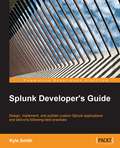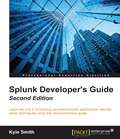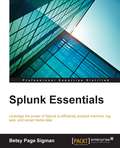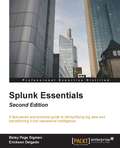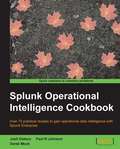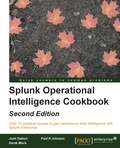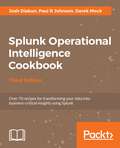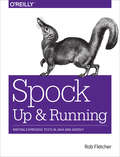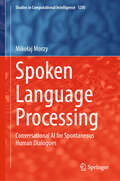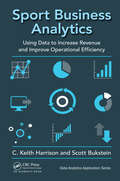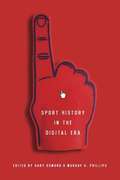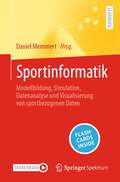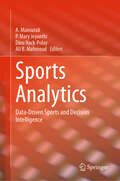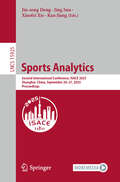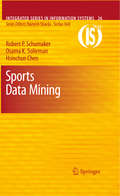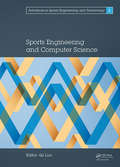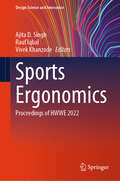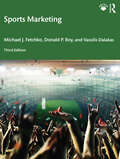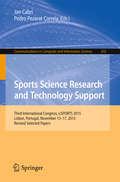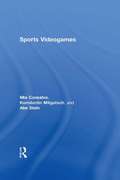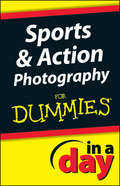- Table View
- List View
Splunk Certified Study Guide: Prepare for the User, Power User, and Enterprise Admin Certifications
by Deep MehtaMake your Splunk certification easier with this exam study guide that covers the User, Power User, and Enterprise Admin certifications. This book is divided into three parts. The first part focuses on the Splunk User and Power User certifications starting with how to install Splunk, Splunk Processing Language (SPL), field extraction, field aliases and macros, and Splunk tags. You will be able to make your own data model and prepare an advanced dashboard in Splunk.In the second part, you will explore the Splunk Admin certification. There will be in-depth coverage of Splunk licenses and user role management, and how to configure Splunk forwarders, indexer clustering, and the security policy of Splunk. You’ll also explore advanced data input options in Splunk as well as .conf file merging logic, btool, various attributes, stanza types, editing advanced data inputs through the .conf file, and various other types of .conf file in Splunk.The concluding part covers the advanced topics of the Splunk Admin certification. You will also learn to troubleshoot Splunk and to manage existing Splunk infrastructure. You will understand how to configure search head, multi-site indexer clustering, and search peers besides exploring how to troubleshoot Splunk Enterprise using the monitoring console and matrix.log. This part will also include search issues and configuration issues. You will learn to deploy an app through a deployment server on your client’s instance, create a server class, and carry out load balancing, socks proxy, and indexer discovery.By the end of the Splunk Certified Study Guide, you will have learned how to manage resources in Splunk and how to use REST API services for Splunk. This section also explains how to set up Splunk Enterprise on the AWS platform and some of the best practices to make them work efficiently together.The book offers multiple choice question tests for each part that will help you better prepare for the exam.What You Will LearnStudy to pass the Splunk User, Power User, and Admin certificate examsImplement and manage Splunk multi-site clusteringDesign, implement, and manage a complex Splunk Enterprise solutionMaster the roles of Splunk Admin and troubleshootingConfigure Splunk using AWSWho This Book Is For People looking to pass the User, Power User, and Enterprise Admin exams. It is also useful for Splunk administrators and support engineers for managing an existing deployment.
Splunk Developer's Guide
by Kyle SmithIf you are a Splunk user and want to enter the wonderful world of Splunk application development, then this book is for you. Some experience with Splunk, writing searches, and designing basic dashboards is expected.
Splunk Developer's Guide - Second Edition
by Kyle SmithLearn the A to Z of building excellent Splunk applications with the latest techniques using this comprehensive guide About This Book * This is the most up-to-date book on Splunk 6.3 for developers * Get ahead of being just a Splunk user and start creating custom Splunk applications as per your needs * Your one-stop-solution to Splunk application development Who This Book Is For This book is for those who have some familiarity with Splunk and now want to learn how to develop an efficient Splunk application. Previous experience with Splunk, writing searches, and designing basic dashboards is expected. What You Will Learn * Implement a Modular Input and a custom D3 data visualization * Create a directory structure and set view permissions * Create a search view and a dashboard view using advanced XML modules * Enhance your application using eventtypes, tags, and macros * Package a Splunk application using best practices * Publish a Splunk application to the Splunk community In Detail Splunk provides a platform that allows you to search data stored on a machine, analyze it, and visualize the analyzed data to make informed decisions. The adoption of Splunk in enterprises is huge, and it has a wide range of customers right from Adobe to Dominos. Using the Splunk platform as a user is one thing, but customizing this platform and creating applications specific to your needs takes more than basic knowledge of the platform. This book will dive into developing Splunk applications that cater to your needs of making sense of data and will let you visualize this data with the help of stunning dashboards. This book includes everything on developing a full-fledged Splunk application right from designing to implementing to publishing. We will design the fundamentals to build a Splunk application and then move on to creating one. During the course of the book, we will cover application data, objects, permissions, and more. After this, we will show you how to enhance the application, including branding, workflows, and enriched data. Views, dashboards, and web frameworks are also covered. This book will showcase everything new in the latest version of Splunk including the latest data models, alert actions, XML forms, various dashboard enhancements, and visualization options (with D3). Finally, we take a look at the latest Splunk cloud applications, advanced integrations, and development as per the latest release. Style and approach This book is an easy-to-follow guide with lots of tips and tricks to help you master all the concepts necessary to develop and deploy your Splunk applications.
Splunk Essentials
by Betsy Page SigmanThis book is intended for a business person, analyst, or student who wants to quickly learn how to use Splunk to manage data. It would be helpful to have a bit of familiarity with basic computer concepts, but no prior experience of Splunk is required.
Splunk Essentials - Second Edition
by Betsy Page Sigman Erickson DelgadoA fast-paced and practical guide to demystifying big data and transforming it into operational intelligence About This Book * Want to get started with Splunk to analyze and visualize machine data? Open this book and step into the world of Splunk. * Leverage the exceptional analysis and visualization capabilities to make informed decisions for your business * This easy-to-follow, practical book can be used by anyone, even if you have never managed any data before Who This Book Is For This book will be perfect for you if you are a Software engineer or developer or System administrators or Business analyst who seek to correlate machine data with business metrics and provide intuitive real-time and statistical visualizations. Some knowledge or experience of previous versions of Splunk will be helpful but not essential. What You Will Learn * Install and configure Splunk * Gather data from different sources, isolate them by indexes, classify them into source types, and tag them with the essential fields * Be comfortable with the Search Processing Language and get to know the best practices in writing search queries * Create stunning and powerful dashboards * Be proactive by implementing alerts and scheduled reports * Use the Splunk SDK and integrate Splunk data into other applications * Implement the best practices in using Splunk. In Detail Splunk is a search, analysis, and reporting platform for machine data, which has a high adoption on the market. More and more organizations want to adopt Splunk to use their data to make informed decisions. This book is for anyone who wants to manage data with Splunk. You'll start with very basics of Splunk-- installing Splunk--and then move on to searching machine data with Splunk. You will gather data from different sources, isolate them by indexes, classify them into source types, and tag them with the essential fields. After this, you will learn to create various reports, XML forms, and alerts. You will then continue using the Pivot Model to transform the data models into visualization. You will also explore visualization with D3 in Splunk. Finally you'll be provided with some real-world best practices in using Splunk. Style and approach This fast-paced, example-rich guide will help you analyze and visualize machine data with Splunk through simple, practical instructions.
Splunk Operational Intelligence Cookbook
by Paul R Johnson Josh DiakunThis book is intended for users of all levels who are looking to leverage the Splunk Enterprise platform as a valuable operational intelligence tool. The recipes provided in this book will appeal to individuals from all facets of a business - IT, Security, Product, Marketing, and many more!
Splunk Operational Intelligence Cookbook - Second Edition
by Paul R Johnson Josh Diakun Derek MockOver 70 practical recipes to gain operational data intelligence with Splunk Enterprise About This Book * This is the most up-to-date book on Splunk 6.3 and teaches you how to tackle real-world operational intelligence scenarios efficiently * Get business insights using machine data using this easy-to-follow guide * Search, monitor, and analyze your operational data skillfully using this recipe-based, practical guide Who This Book Is For This book is intended for users of all levels who are looking to leverage the Splunk Enterprise platform as a valuable operational intelligence tool. The recipes provided in this book will appeal to individuals from all facets of business, IT, security, product, marketing, and many more! Also, existing users of Splunk who want to upgrade and get up and running with Splunk 6.3 will find this book invaluable. What You Will Learn * Use Splunk to gather, analyze, and report on data * Create dashboards and visualizations that make data meaningful * Build an operational intelligence application with extensive features and functionality * Enrich operational data with lookups and workflows * Model and accelerate data and perform pivot-based reporting * Build real-time, scripted, and other intelligence-driven alerts * Summarize data for longer term trending, reporting, and analysis * Integrate advanced JavaScript charts and leverage Splunk's API In Detail Splunk makes it easy for you to take control of your data, and with Splunk Operational Cookbook, you can be confident that you are taking advantage of the Big Data revolution and driving your business with the cutting edge of operational intelligence and business analytics. With more than 70 recipes that demonstrate all of Splunk's features, not only will you find quick solutions to common problems, but you'll also learn a wide range of strategies and uncover new ideas that will make you rethink what operational intelligence means to you and your organization. You'll discover recipes on data processing, searching and reporting, dashboards, and visualizations to make data shareable, communicable, and most importantly meaningful. You'll also find step-by-step demonstrations that walk you through building an operational intelligence application containing vital features essential to understanding data and to help you successfully integrate a data-driven way of thinking in your organization. Throughout the book, you'll dive deeper into Splunk, explore data models and pivots to extend your intelligence capabilities, and perform advanced searching to explore your data in even more sophisticated ways. Splunk is changing the business landscape, so make sure you're taking advantage of it. Style and approach Splunk is an excellent platform that allows you to make sense of machine data with ease. The adoption of Splunk has been huge and everyone who has gone beyond installing Splunk wants to know how to make most of it. This book will not only teach you how to use Splunk in real-world scenarios to get business insights, but will also get existing Splunk users up to date with the latest Splunk 6.3 release.
Splunk Operational Intelligence Cookbook: Over 80 recipes for transforming your data into business-critical insights using Splunk, 3rd Edition
by Paul R Johnson Josh Diakun Derek MockLeverage Splunk's operational intelligence capabilities to unlock new hidden business insights and drive successKey FeaturesTackle any problems related to searching and analyzing your data with Splunk Get the latest information and business insights on Splunk 7.x Explore the all new machine learning toolkit in Splunk 7.xBook DescriptionSplunk makes it easy for you to take control of your data, and with Splunk Operational Cookbook, you can be confident that you are taking advantage of the Big Data revolution and driving your business with the cutting edge of operational intelligence and business analytics.With more than 80 recipes that demonstrate all of Splunk’s features, not only will you find quick solutions to common problems, but you’ll also learn a wide range of strategies and uncover new ideas that will make you rethink what operational intelligence means to you and your organization.You’ll discover recipes on data processing, searching and reporting, dashboards, and visualizations to make data shareable, communicable, and most importantly meaningful. You’ll also find step-by-step demonstrations that walk you through building an operational intelligence application containing vital features essential to understanding data and to help you successfully integrate a data-driven way of thinking in your organization.Throughout the book, you’ll dive deeper into Splunk, explore data models and pivots to extend your intelligence capabilities, and perform advanced searching with machine learning to explore your data in even more sophisticated ways. Splunk is changing the business landscape, so make sure you’re taking advantage of it.What you will learnLearn how to use Splunk to gather, analyze, and report on dataCreate dashboards and visualizations that make data meaningfulBuild an intelligent application with extensive functionalitiesEnrich operational data with lookups and workflowsModel and accelerate data and perform pivot-based reportingApply ML algorithms for forecasting and anomaly detectionSummarize data for long term trending, reporting, and analysisIntegrate advanced JavaScript charts and leverage Splunk's APIWho this book is forThis book is intended for data professionals who are looking to leverage the Splunk Enterprise platform as a valuable operational intelligence tool. The recipes provided in this book will appeal to individuals from all facets of business, IT, security, product, marketing, and many more! Even the existing users of Splunk who want to upgrade and get up and running with Splunk 7.x will find this book to be of great value.
Spock: Writing Expressive Tests in Java and Groovy
by Rob FletcherMost developers would agree that writing automated tests is a good idea, but writing good, well-structured tests is still an elusive skill for many. For Java and Groovy developers, however, there’s good news. This practical guide shows you how to write concise and highly readable tests with Spock, the most innovative testing and specification framework for the JVM since JUnit.Author Rob Fletcher takes you from Spock basics to advanced topics, using fully worked integration examples. Through the course of this book, you’ll build a simple web application—Squawker—that allows users to post short messages. You’ll discover how much easier it is to write automated tests with Spock’s straightforward and expressive language.Start by learning how to write simple unit testsUnderstand the lifecycle of Spock specifications and feature methodsDive into interaction testing, using Spock’s intuitive syntax for dealing with mocks and stubsLearn about parameterized tests—writing feature methods that run for multiple sets of dataMove into advanced topics, such as writing idiomatic Spock code and driving parameterized tests with file or database inputLearn how everything works together in a standalone, fully-worked, test-driven development example
Spoken Language Processing: Conversational AI for Spontaneous Human Dialogues (Studies in Computational Intelligence #1205)
by Mikołaj MorzyThis book tackles the complexities of spontaneous human dialogues, exploring the challenges of unscripted conversations with their interruptions, overlaps, and disfluencies for conversational AI. It provides a comprehensive exploration of the differences between spontaneous and prescriptive languages, examining the impact of these differences on machine learning models. The author examines the technical aspects of processing spontaneous speech, including automatic speech recognition and transcript engineering, discussing the design and development of AI systems capable of handling the nuances of spontaneous dialogues. Written for researchers in natural language processing and students interested in AI and machine learning applications for spontaneous human communication, this book serves as a guide for understanding the latest advancements in the field and developing more robust and effective Conversational AI systems.
Sport Business Analytics: Using Data to Increase Revenue and Improve Operational Efficiency (Data Analytics Applications)
by Scott Bukstein C. HarrisonDeveloping and implementing a systematic analytics strategy can result in a sustainable competitive advantage within the sport business industry. This timely and relevant book provides practical strategies to collect data and then convert that data into meaningful, value-added information and actionable insights. Its primary objective is to help sport business organizations utilize data-driven decision-making to generate optimal revenue from such areas as ticket sales and corporate partnerships. To that end, the book includes in-depth case studies from such leading sports organizations as the Orlando Magic, Tampa Bay Buccaneers, Duke University, and the Aspire Group. The core purpose of sport business analytics is to convert raw data into information that enables sport business professionals to make strategic business decisions that result in improved company financial performance and a measurable and sustainable competitive advantage. Readers will learn about the role of big data and analytics in: Ticket pricing Season ticket member retention Fan engagement Sponsorship valuation Customer relationship management Digital marketing Market research Data visualization. This book examines changes in the ticketing marketplace and spotlights innovative ticketing strategies used in various sport organizations. It shows how to engage fans with social media and digital analytics, presents techniques to analyze engagement and marketing strategies, and explains how to utilize analytics to leverage fan engagement to enhance revenue for sport organizations. Filled with insightful case studies, this book benefits both sports business professionals and students. The concluding chapter on teaching sport analytics further enhances its value to academics.
Sport History in the Digital Era
by Murray G Phillips Gary OsmondFrom statistical databases to story archives, from fan sites to the real-time reactions of Twitter-empowered athletes, the digital communication revolution has changed the way fans relate to LeBron's latest triple double or Tom Brady's last second touchdown pass. In this volume, contributors from Australia, Ireland, New Zealand, the United Kingdom, and the United States analyze the parallel transformation in the field of sport history, showing the ways powerful digital tools raise vital philosophical, epistemological, ontological, methodological, and ethical questions for scholars and students alike. Chapters consider how philosophical and theoretical understandings of the meaning of history influence engagement with digital history, and conceptualize the relationship between history making and the digital era. As the writers show, digital media's mostly untapped potential for studying the recent past via media like blogs, chat rooms, and gambling sites forge a symbiosis between sports and the internet while offering historians new vistas to explore and utilize. In this new era, digital history becomes a dynamic site of enquiry and discussion where scholars enter into a give-and-take with individuals and invite their audience to grapple with, rather than passively absorb, evidence. Timely and provocative, Sport History in the Digital Era affirms how the information revolution has transformed sport and sport history--and shows the road ahead. Contributors include Douglas Booth, Mike Cronin, Martin Johnes, Matthew Klugman, Geoffery Z. Kohe, Tara Magdalinski, Fiona McLachlan, Bob Nicholson, Rebecca Olive, Gary Osmond, Murray G. Phillips, Stephen Robertson, Synthia Sydnor, Holly Thorpe, and Wayne Wilson.
Sport and Video Games (Frontiers of Sport)
by Łukasz MuniowskiThis book explores the complex relationships between sport and video games, two of the largest entertainment sectors globally.Focusing on those games that depict real-life sports and athletic competitions, from FIFA, Madden, and NBA 2K to Football Manager and Tony Hawk’s Pro Skater, the book examines how sport has influenced gaming, and vice versa, and how this relationship is likely to develop in the future. Arguing that sports games are a unique interface between virtual worlds and our real-life social worlds, the book examines the concept of simulation; how the performance of athletes and teams in the real world influences video games; and whether those close links enhance or limit the player’s experience. It also considers how video games are used by leagues and sports franchises, through sponsorship and in-game advertisements, to reinforce their brands. Furthermore, it presents a concise history of sports video games, and using narrative methods, it takes a close look at the importance of storytelling in sports video games, not only in the sense of the stories built into the structure of a game but also in the way that fans and media organizations build their own stories in sport, in both real and virtual worlds. The book also asks how sports video games illuminate our understanding of key social issues, including race and gender.This is fascinating reading for anybody with an interest in the sociology or culture of sport or video games, sport business, or the gaming industry.
Sportinformatik: Modellbildung, Simulation, Datenanalyse und Visualisierung von sportbezogenen Daten
by Daniel MemmertIn den letzten Jahren ist die Sportinformatik extrem gewachsen, vor allem weil immer mehr und neuere Daten verfügbar wurden. Sportinformatische Tools – sei es im Training zur Gegnervorbereitung, im Wettkampf oder in der Wissenschaft – sind im Sport heute auf unterschiedlichen Expertise-Ebenen unverzichtbar. Durch den Einsatz in den vier großen Anwendungsfeldern Vereine und Verbände, Wirtschaft, Wissenschaft sowie Medien ist ein völlig neuer Markt entstanden, der innerhalb der universitären Forschungs- und Lehraktivitäten zunehmend an Bedeutung gewinnt.Dieses Lehrbuch möchte der mittlerweile breiten Vielfalt der Sportinformatik gerecht werden, indem mehr als 30 Autorinnen und Autoren aus ihrem Spezialgebiet berichten und neueste Erkenntnisse prägnant zusammenfassen. Das Werk gliedert sich in vier Hauptabschnitte: Datensätze, Modellbildung, Simulation sowie Datenanalyse. Neben Hintergründen zu Programmiersprachen und zur Visualisierung wird es von der Historie und einem Ausblick eingerahmt. Studierende mit Bezug zur Sportwissenschaft erhalten einen umfassenden Einblick in die Sportinformatik, unterstützt durch ein didaktisch ausgefeiltes Konzept, das eine einfache Vermittlung der Lerninhalte ermöglicht. Zahlreiche digitale Übungsfragen untermauern den Lerneffekt und gewährleisten eine optimale Prüfungsvorbereitung. Für Fortgeschrittene bietet die vertiefende Diskussion von Zeitreihen Data Mining, künstlichen neuronalen Netzwerken, Convolution Kernel, Transfer Learning und Random Forests einen zusätzlichen Mehrwert.
Sports Analytics: Data-Driven Sports and Decision Intelligence
by Dieu Hack-Polay Ali B. Mahmoud P. Mary Jeyanthi A. MansuraliIn "Sports Analytics: Data-Driven Sports and Decision Intelligence," embark on a journey through the exhilarating world of sports enhanced by the power of data-driven insights. From the nail-biting moments on the field to the strategic decisions behind the scenes, this comprehensive guide unveils the secrets that propel teams to victory and champions to greatness.It explores the cutting-edge techniques and methodologies that revolutionize the way we understand and analyze sports performance. From player evaluations to game strategies, injury prevention to fan engagement, this book equips you with the tools to gain a competitive edge in any sport. Whether you're a coach, player, analyst, or simply a passionate fan, this book will change the way you see the game. This book details how to use analytics and machine learning to highlight key performance indicators (KPIs) of sports for analysis. The authors show how to apply various statistical techniques, machine learning and data mining algorithms for on-field and off-field analysis. They go on to show how analytical algorithms are used in the sports ecosystem to derive solutions for the team and leadership, helping team managers and coaches to monitor games and player information through dashboards. The book then shows how to deploy machine learning algorithms for validating and improving teams and players performance. The book is relevant to professionals and academics working in machine learning and data analysis related to sports.
Sports Analytics: First International Conference, ISACE 2024, Paris, France, July 12–13, 2024, Proceedings (Lecture Notes in Computer Science #14794)
by Jin Song Dong Zhe Hou Masoumeh IzadiThis book constitutes the refereed proceedings of the First International Conference on Sports Analytics, ISACE 2024, held in Paris, France, during July 12–13, 2024. The 19 full papers, 1 short paper and 7 Practical Experience papers included in this volume were carefully reviewed and selected from a total of 66 submissions. The vision of this new International Sports Analytics Conference and Exhibition (ISACE) series is to bring leading academics, researchers, coaches, psychologists, managers and technologists together to advance the state-of-the-art of sports analytics.
Sports Analytics: Second International Conference, ISACE 2025, Shanghai, China, September 26–27, 2025, Proceedings (Lecture Notes in Computer Science #15925)
by Jing Sun Jin-Song Dong Xiaofei Xie Kan JiangThis book LNCS 15925 constitutes the refereed proceedings of the Second International Conference on Sports Analytics, ISACE 2025, held in Shanghai, China, during September 26-27, 2025. The 21 full papers were carefully reviewed and selected from 57 submissions. These papers explore the frontiers of sports analytics, which is an interdisciplinary field that integrates artificial intelligence, data science, psychology, and smart devices to enhance athletic performance, strategy, and decision-making.
Sports Data Mining
by Hsinchun Chen Osama K. Solieman Robert P. SchumakerData mining is the process of extracting hidden patterns from data, and it's commonly used in business, bioinformatics, counter-terrorism, and, increasingly, in professional sports. First popularized in Michael Lewis' best-selling Moneyball: The Art of Winning An Unfair Game, it is has become an intrinsic part of all professional sports the world over, from baseball to cricket to soccer. While an industry has developed based on statistical analysis services for any given sport, or even for betting behavior analysis on these sports, no research-level book has considered the subject in any detail until now. Sports Data Mining brings together in one place the state of the art as it concerns an international array of sports: baseball, football, basketball, soccer, greyhound racing are all covered, and the authors (including Hsinchun Chen, one of the most esteemed and well-known experts in data mining in the world) present the latest research, developments, software available, and applications for each sport. They even examine the hidden patterns in gaming and wagering, along with the most common systems for wager analysis.
Sports Engineering and Computer Science: Proceedings of the International Conference on Sport Science and Computer Science (SSCS 2014), Singapore, 16-17 September 2014 (Advances in Sports Engineering and Technology)
by Qi LuoSports Engineering and Computer Science contains papers presented at the 2014 International Conference on Sport Science and Computer Science (SSCS 2014), held September 16-17, 2014 in Singapore and at the 2014 International Conference on Biomechanics and Sports Engineering (BSE 2014), held October 24-25, 2014, in Riga, Latvia. The contributions hav
Sports Ergonomics: Proceedings of HWWE 2022 (Design Science and Innovation)
by Rauf Iqbal Vivek Khanzode Ajita D. SinghThis book presents select proceedings of the International Conference on Humanizing Work and Work Environment (HWWE-2022) conducted at Punjabi University, Patiala. The conference proceedings examine a range of issues confronted by researchers and practitioners in the field of ergonomics and human factors engineering today. The book showcases latest research on physical ergonomics, workplace design, product design for usability, user interface and experience design, and assessment of cognitive workload, among other topics. The book also discusses various methodological approaches used by researchers and scientists in the field of ergonomics, such as participatory ergonomics, survey research, experimental design, data driven modeling and other recent approaches. This book will be a useful reference for researchers, practitioners, professionals, and consultants in the field of ergonomics, human factors engineering, and worksystem design.
Sports Marketing
by Donald P. Roy Michael J. Fetchko Vassilis DalakasHighly practical and engaging, Sports Marketing equips students with the skills, techniques, and tools they need to be successful marketers in any sporting environment. The book blends relevant marketing theory—focusing on industry-specific terminology and practices—with practitioner insights into current issues and future directions in the sports industry. This anticipated third edition has been fully updated to incorporate a broad range of global and diverse perspectives from industry experts and international case studies throughout. Contemporary topics within the sports industry have been expanded upon, including esports, social responsibility, sustainability, digital and social media, and personal branding. Popular "You Make the Call" cases, insider and early career insights, and review questions stimulate lively classroom discussion, while chapter summaries and terms support further support learning. Overall, this exciting text will: • Increase students’ depth of knowledge about sports marketing • Challenge students to apply concepts to real-world situations • Profile best practices of organizations and individuals within the sports industry as they relate to the book’s content • Equip students to position themselves to compete for entry-level positions in sports business • Provide faculty with a concise but thorough text that meets their needs. Sports Marketing remains a core textbook for undergraduate and postgraduate students of sports marketing and management, providing a firm grasp of the ins and outs of working in sports. Additional online resources include PowerPoint slides for each chapter, a test bank of questions, and an instructor’s manual.
Sports Research with Analytical Solution using SPSS
by J. P. VermaA step-by-step approach to problem-solving techniques using SPSS® in the fields of sports science and physical education Featuring a clear and accessible approach to the methods, processes, and statistical techniques used in sports science and physical education, Sports Research with Analytical Solution using SPSS® emphasizes how to conduct and interpret a range of statistical analysis using SPSS. The book also addresses issues faced by research scholars in these fields by providing analytical solutions to various research problems without reliance on mathematical rigor. Logically arranged to cover both fundamental and advanced concepts, the book presents standard univariate and complex multivariate statistical techniques used in sports research such as multiple regression analysis, discriminant analysis, cluster analysis, and factor analysis. The author focuses on the treatment of various parametric and nonparametric statistical tests, which are shown through the techniques and interpretations of the SPSS outputs that are generated for each analysis. Sports Research with Analytical Solution using SPSS® also features: Numerous examples and case studies to provide readers with practical applications of the analytical concepts and techniques Plentiful screen shots throughout to help demonstrate the implementation of SPSS outputs Illustrative studies with simulated realistic data to clarify the analytical techniques covered End-of-chapter short answer questions, multiple choice questions, assignments, and practice exercises to help build a better understanding of the presented concepts A companion website with associated SPSS data files and PowerPoint® presentations for each chapter Sports Research with Analytical Solution using SPSS® is an excellent textbook for upper-undergraduate, graduate, and PhD-level courses in research methods, kinesiology, sports science, medicine, nutrition, health education, and physical education. The book is also an ideal reference for researchers and professionals in the fields of sports research, sports science, physical education, and social sciences, as well as anyone interested in learning SPSS.
Sports Science Research and Technology Support: Third International Congress, icSPORTS 2015, Lisbon, Portugal, November 15-17, 2015, Revised Selected Papers (Communications in Computer and Information Science #632)
by Jan Cabri and Pedro Pezarat CorreiaThis book contains extended and revised versions of selected papers from the Third International Congress on Sports Science Research and Technology Support, icSPORTS 2015, held in Lisbon, Portugal, in 2015.The 9 thoroughly revised and extended papers presented in this volume were carefully reviewed and selected from originally 93 submissions. The papers cover topics in the following main areas: signal processing and motor behavior; sports medicine and support technology; health, sports performance and support technology; and computer systems in sports.
Sports Videogames
by Mia Consalvo Abe Stein Konstantin MitgutschFrom Pong to Madden NFL to Wii Fit, Sports Videogames argues for the multiple ways that sports videogames—alongside televised and physical sports—impact one another, and how players and viewers make sense of these multiple forms of play and information in their daily lives. Through case studies, ethnographic explorations, interviews and surveys, and by analyzing games, players, and the sports media industry, contributors from a wide variety of disciplines demonstrate the depth and complexity of games that were once considered simply sports simulations. Contributors also tackle key topics including the rise of online play and its implications for access to games, as well as how regulations surrounding player likenesses present challenges to the industry. Whether you’re a scholar or a gamer, Sports Videogames offers a grounded, theory-building approach to how millions make sense of videogames today.
Sports and Action Photography In A Day For Dummies (In A Day For Dummies)
by Jonathan StreetmanTake better actions shots with this terrific, 100-page e-book! From pro to hobbyist, from your child's first baseball game to the championship match, every photographer wants to be able to capture thrilling action shots. Now you can sharpen your photography skills with this fast-paced, In A Day For Dummies e-book that really zeros in on the specifics. See how to freeze action, add motion blur, and work with the variety of conditions you'll face when shooting live action. Focuses on techniques that help you successfully capture sports and live action photographs, such as freezing action or adding motion blur Covers getting the right gear, setting your camera for the shot, capturing the shot, editing the results, and more Includes a "Beyond the book" online component, where you can find step-by-step tutorials, videos, and a bonus lesson on creating a high-dynamic range sports photo Shows you techniques that work effectively on digital SLR cameras and point-and-shoot cameras Get Sports & Action Photography In A Day For Dummies and take action!

